NJ Teachers of English to Speakers of Other Languages/
NJ Bilingual Educators
ARTICLES – SUMMER 2021
4 Ways to Take a Real Break This Summer
Outgoing Executive Board Members
No Language Trade-off: Bilingual Children Reliably Acquire English by Age 5
2021 Scholarship and Award Winners
Meet Our New Executive Board Members
The Six Most Effective Instructional Strategies for Ells According to Teachers
English-Learners May Need More Support This Fall. But That Doesn’t Mean They’re Behind– Ileana Najarro
Celebrating Multilingual Learner Identity through Personal Narrative Instruction
Countering Anti-Black Racism in Ourselves and in Our Classrooms– Tasha Austin
5 Ways Phonics is Different for English Learners– Barbara Gottschalk
Language Transfer The Interaction Between English and Students’ Primary Languages
What the Kahoot? Michelle Land
Building Momentum with Long-Term English Learners– Louise El Yaafouri
How To Help Students with Reading and L2 Acquisition
Mental Health Problems Loom for the COVID Generation. Here’s What Schools Can Do-Arianna Prothero
Helping Students Bounce Back from a Disrupted Year: Strategies for Schools
What Students Will Need as the Year Begins -Lori Desautels
‘You Can’t Lead on Empty’: On Supporting Staff With Vicarious Trauma– Paige Tutt
5 Ways to Support the Families of Multilingual Learners When School Opens -Judie Haynes
Welcoming Back English Learners
Assessment Strategies for English-Language Learners -Larry Ferlazzo
Looking Back– Marilyn Pongracz
Teach Us Your Name-Kathleen Fernandez
Conversations with Tim: A student’s perspective on living and learning during the pandemic
June 22, 2021
4 Ways to Take a Real Break This Summer
 For everyone, this has been an extraordinarily difficult year. Crystal Frommert, the author of this article, advocates taking a genuine break. She lists what to do, and most importantly, what not to do, and at the top of that list is not overdoing professional development.
For everyone, this has been an extraordinarily difficult year. Crystal Frommert, the author of this article, advocates taking a genuine break. She lists what to do, and most importantly, what not to do, and at the top of that list is not overdoing professional development.
First, read something fun, even a book or books with little literary quality.
Second, don’t teach! Find another type of job if you need income. It will help you to meet new people and possibly learn a new skill.
Third, instead of engaging in a lot of PD, cultivate a new hobby such as painting, knitting, or Yoga and do it every day. YouTube is a wonderful resource for learning something new. Alternatively, she also suggests learning a new language or volunteering.
Finally, she suggests reflection, but not on the past school year. Instead, focus on the upcoming summer. Keep a journal of what you’ve done for yourself. Be sure you can say, “I am so glad I did _____ for myself this summer.”
Ms. Frommert’s conclusion is not to let the guilt of what you think you should be doing derail your summer break so you can start September fully refreshed.
Article recommended by Hana Prashker
Outgoing Executive Board Members
NJTESOL/NJBE would like to recognize and thank the outgoing executive Board members for their service to our organization.
They have met faithfully on a Friday evening once a month and two Saturdays during the year, advocating for students and teachers. They have joined related professional associations, answered questions on the hotlist, read scholarship and award applications to choose the winners, presented workshops, and assisted with the Spring Conference.
 Thank you!
Thank you!
- Sonya Bertini, WIDA Representative
- Greg Romero, Secretary
- Patricia George, Higher Education SIG Rep
- Sheba Koshy, Middle School ESL SIG Rep
- Solange Lopes Murphy, Special Education SIG Rep
- Angela Pape, ESL Elementary SIG Rep
- Hana Prashker, Secondary ESL SIG Rep
June 29, 2021
No Language Trade-off:
Bilingual Children Reliably Acquire English by Age 5
 Researchers at Florida Atlantic University, in collaboration with others at The George Washington University, conducted a first of its kind study of children who learn a minority language at home, and who, at the same time, are also exposed to English.
Researchers at Florida Atlantic University, in collaboration with others at The George Washington University, conducted a first of its kind study of children who learn a minority language at home, and who, at the same time, are also exposed to English.
This study is unique in that it assessed the degree of language development in bilingual five-year-olds, correlated the development of both languages, and addressed the question of how much language development can be expected at this age.
Although these children usually start to speak a little later than their monolingual peers, the study found that growing up bilingual does not hinder language development.
Interestingly, the researchers found that children whose parents were highly educated in Spanish, and in whose homes Spanish was the main language, had the most balanced development in both English and Spanish. For these children, development in English was the same as children for whom English was the dominant language. By age five, English became the dominant language for children who learned both languages despite variations among the children in the study.
The study also confirmed that low proficiency in both languages was caused by learning difficulties or little support for learning both languages.
Read the article and related studies.
Article recommended by Kathleen Fernandez, NJTESOL/NJBE Executive Director
 NJTESOL/NJBE
NJTESOL/NJBE
2021 Scholarship and Award Winners
Congratulations to All!
Fourth Grade Awards
Isabela Ferreira & Giovana Cabral
Eighth Grade Awards
Dea Elezaj & Helen Martinez-Barreto
Raquel Sinai Newcomer Scholarships
Bahtiyar Goktas & Tabata Bustos
Pedro J. Rodriguez High School Scholarships
Adil Abdullah & Anilsi Jimenez Bigay
Seal of Bilteracy Scholarships
Numan Kose & Johmara Paredes
Higher Education Scholarships
Pinar Uzulmez & Mariam Beshara
Dr. Reppy Graduate Student Scholarship
Jessica Leonardis
Judie Haynes’ Grant for ESL/Bilingual Teachers
Sharon Kernan
President’s Award
Dr. Mary Reece
Leadership Award
Julie Ochoa
Advocacy Award
Violetta Katsikis
Seal of Biliteracy Superintendent of the Year
Dr. Jeffrey Moore
2021 Scholarship and Award Winner’s Photo Gallery
July 6, 2021
Meet Our New Executive Board Members
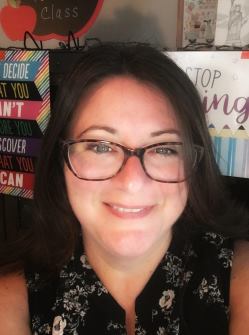 Luigina Finneran, Bilingual/ESL Middle School Representative
Luigina Finneran, Bilingual/ESL Middle School Representative
I have been in education for almost 20 years, first as a K-8 Spanish teacher and now as a 5-8 teacher of ELLs in Fair Lawn. Being first generation has allowed me to connect to and help my students and their families. I am passionate about educating all stakeholders of our students. I do this through presentations at my district for parents and teachers, as well as the Chair of the Bergen County chapter of NJTESOL/NJBE, and now also as the Bilingual/ESL Middle School 6-8 Representative on the Executive Board.
 Pedro Trivella, ESL Elementary 1-5 Representative
Pedro Trivella, ESL Elementary 1-5 Representative
I am a driven global ambassador with multicultural DNA. My life experiences as a second language learner have equipped me with the empathic “Teaching to the Whole Child” philosophy that I passionately embrace. I am a Fulbright scholar who is currently working as an ESL/Bilingual K-3 teacher at the Asbury Park school district.
 Elsa Capote Wajda, ESL Secondary Representative
Elsa Capote Wajda, ESL Secondary Representative
This June I completed my 17th year teaching ESL at Palisades Park Jr/Sr High School. I hold a Master of Arts degree from Montclair State University. There I attained certifications in ESL, K-6 Elementary Education, Reading Specialist and Supervision. As a teacher of teenagers I have taught all levels of ESL, from saying hello to critical thinking to teaching life skills. Most importantly, my students have taught me compassion, and to be a good listener. The smallest things do make a big difference!
Adela Joyce, Special Education Representative
I am currently working at the Paterson Public District as an ESL/Bilingual Teacher. I find every opportunity in my teacher position to advocate for ESL/Bilingual students and special education issues. My philosophy is to create and maintain a healthy and equal opportunity to all in the education field. “We are equally different”
Calling all NJTESOL/NJBE Virtual Spring Conference Attendees!
Good news! All registered attendees can still access pre-recorded conference sessions! That’s right. A benefit of our virtual platform is that you have time to leisurely enjoy the sessions on the conference platform website. Just search for the login information that you received in May and you’re all set. Enjoy!
Sandee McBride, Conference Coordinator
The Six Most Effective Instructional Strategies for Ells According to Teachers
By Larry Ferlazzo
Larry Ferlazzo shares his ideas along with those of four other educators about their most effective strategies. He mentions his two favorites, the Language Experience Approach (LEA) and Total Physical Response (TPR). In LEA, all of the students participate in an activity, and then the teacher helps them write about it in either simple or complex sentences depending on their proficiency in English. He writes that TPR is playful, and then links resources for implementing it.
The first contributing teacher, Valentina Gonzalez, describes the Picture Word Inductive Model as asset-based because it “…leverages students’ funds of knowledge and builds upon them.” She offers tips about how to use this method successfully. The teacher should find intriguing, age-appropriate images, color-code the parts of speech, keep sentence frames at the students’ levels, and allow ample time, even a few days, to complete the activity. She provides a “How To” link.
Denita Harris, the second contributor, recommends Sentence Frames paired with a word bank, phrases, and even pictures. She states that students have the tools they need to express themselves in their native languages, but they do not have these yet in English. Sentence frames provide these tools. She concludes that “When students have the language to contribute to classroom discussions and are able to express their thoughts on paper, they begin to feel a part of the classroom community, and that makes all the difference.”
 Cindy Garcia describes three strategies for providing effective Comprehensible Input. The first is to speak slowly and clearly, being especially careful about the beginning and ending sounds of words. The second is to avoid idioms and figures of speech. The third is using TPR and gestures.
Cindy Garcia describes three strategies for providing effective Comprehensible Input. The first is to speak slowly and clearly, being especially careful about the beginning and ending sounds of words. The second is to avoid idioms and figures of speech. The third is using TPR and gestures.
Deedy Camarena employs Collaborative Summarizing. The purpose of this is to develop comprehension and proficiency in oral expression. She chooses a reading passage that fits her students’ language level and models how to find the 3-5 important ideas in the text. From this, the students write a 15 word summary. Next, the students work collaboratively with partners to find three to six main ideas from the same passage and write another 15 word summary. Then each pair meets with another pair of students, and the group of four repeats the process. Once that is completed, each group of four joins with another group and again repeats the process. Finally, the groups edit their summaries, practice reading them, and read them to the class.
July 13, 2021
English-Learners May Need More Support This Fall. But That Doesn’t Mean They’re Behind.
A case study on using home language as a bridge to English practice
By Ileana Najarro
 The author compiles advice from teachers, coaches, instructional experts, and parents about how to support students when they return to school in person. While ELs generally had fewer opportunities to practice English through remote learning than they would have had in school, they may have progressed in their first language through more interaction with their families. If the home-language skills have improved, this will help them in English, too. They can use their home language to build their knowledge. Those who have limited literacy in their native language need classes that help them develop their first language skills.
The author compiles advice from teachers, coaches, instructional experts, and parents about how to support students when they return to school in person. While ELs generally had fewer opportunities to practice English through remote learning than they would have had in school, they may have progressed in their first language through more interaction with their families. If the home-language skills have improved, this will help them in English, too. They can use their home language to build their knowledge. Those who have limited literacy in their native language need classes that help them develop their first language skills.
Teachers should not assume that students have or have not progressed in their English skills. To determine each student’s language ability, whatever test results are available can be combined with more recent informal assessments. It is imperative that teachers build on students’ language skills by scaffolding content rather than teaching English in isolation.
Another recommendation is summer or after-school classes or tutoring to give students a boost.
The parents who were interviewed for this article emphasized the importance of outreach to families by translating information from the schools, and where possible, holding meetings in two languages. The social-emotional well-being of the students and their families should also be a priority.
Celebrating Multilingual Learner Identity through Personal Narrative Instruction
By Kate Kinsella, Ed.D.
 Kate Kinsella shares her methods for preparing students to successfully complete a personal narrative assignment.
Kate Kinsella shares her methods for preparing students to successfully complete a personal narrative assignment.
She states that trying to learn in isolation has “…left scores [of English learners] in dire need of lessons that affirm their identities while advancing their academic communication skills.” To meet this need, teachers of students in grades 4-12 may give narrative assignments about cultural and multilingual experiences. However, these are problematic for students because they are more complex than teachers realize. An effective narrative doesn’t result from merely asking a student to write about a topic.
Dr. Kinsella describes what doesn’t work, and delineates the support and guidance that students need: background information and examples of the type of texts they will be asked to produce along with corresponding grammar and vocabulary. She advocates for curriculum and instruction that is asset-based and uses metacognition to give students active control of their learning.
She provides a sample assignment she created, and the steps teachers can follow in creating their own assignments, including examples and information for each one.
- Write an appropriate, relevant, and high-interest prompt – about three to four sentences that guide the focus of the essay
- Prepare a clear definition of the academic writing type – brief and level appropriate
- Identify, adapt, or design a student-friendly analytic scoring guide – clear and specific, separating content and language
- Identify, adapt, or write an appropriate exemplar text – including precise directions for peer review.
- Determine language priorities for exemplar analysis and instruction – see her examples
- Design a prewriting discussion guide with relevant language supports – for students to build the language that they will use in their writing.
Dr. Kinsella’s goal is that
…fellow educators across the nation will devote some precious real-time instructional minutes to a personal narrative unit with more than one opportunity for multilingual learners to build their communicative competence while reflecting on their unique cultural and linguistic histories.
See the article with details and examples.
July 20, 2021
Countering Anti-Black Racism in Ourselves
and in Our Classrooms
 Judie Haynes, an NJTESOL/NJBE Past-President, Voices Editor, and Scholarship Coordinator, is also an author. She posts a blog with TESOL, the international organization.
Judie Haynes, an NJTESOL/NJBE Past-President, Voices Editor, and Scholarship Coordinator, is also an author. She posts a blog with TESOL, the international organization.
She invited Tasha Austin to be a guest columnist. She is the Teacher Ed Representative for NJTESOL/NJBE. She also guided our organization’s efforts to counter Anti-black racism, focusing on English learners.
If you have not had the opportunity to read the full article, it is linked below.
While Austin acknowledges that there are already overwhelmingly numerous expectations for teachers of multilingual learners, for those of us who are unfamiliar with the issue, it is necessary to examine our beliefs, challenge our misunderstandings, and watch for our own biases in order to to root out our often unrecognized anti-Black racism.
Although even the language that is accepted in school and educated society is founded in white supremacy, we can avoid perpetuating linguistic racism by committing ourselves to changing our own attitudes. We must educate ourselves to the realities of others’ experiences to understand their perspective and avoid perpetuating the status quo.
Austin suggests that “As you tend to your mental, physical, and emotional well-being this summer, also ensure it is a time of deep reflection and learning in order to increase effectiveness with Black multilingual students.”
See the article and check the links in it.
Also see the NJTESOL/NJBE statement on anti-black racism
No Longer the Silent Subgroup
 One of the articles that Tasha Austin suggested is No Longer the Silent Subgroup by Ayanna Cooper, Kisha C. Bryan, and Babatunji Ifarinu
One of the articles that Tasha Austin suggested is No Longer the Silent Subgroup by Ayanna Cooper, Kisha C. Bryan, and Babatunji Ifarinu
The authors write that many educators are unaware that Black ELs exist, yet they make up as much as 20% of the EL population in various states.
Those who are born in the United States and speak African American Vernacular English (AAVE), can also understand and speak Standard American English, so they are ineligible for language services. However, because the language of students from the Caribbean is a mix of English Creole, AAVE, and standard English, it is difficult to determine if they need language services or not, although many perform poorly in school.
While the first language of most ELs is clearly not English, it is the basis for building their second. However, AAVE or other varieties of English are not used as a foundation because they are considered inappropriate in the classroom. The reason, according to a quotation from James Baldwin, is that it “has absolutely nothing to do with language itself but with the role of language and the status of its speakers. If the speakers are devalued and marginalized, then so will their language be devalued and marginalized.”
The authors state that the issue must first be addressed in teacher education programs, and through outreach to the community to “actively seek ways to show culturally and linguistically diverse members of the community as role models.” Students’ language must be considered an asset while their social and emotional needs are met and guidance is provided for their academic development.
July 27, 2021
5 Ways Phonics is Different for English Learners
By Barbara Gottschalk
 In an article in Chalkbeat on difficulties English Learners were having in the Philadelphia School District, an ESL teacher, Shuxin Chen, mentioned the “double burden” young ELs face during phonics lessons. Barbara Gottschalk looks at this foundational reading skill and the additional considerations needed for ELs. In conversation with Ms. Chen, they arrived at 5 differences that need to be addressed when teaching phonics to ELs learning to read.
In an article in Chalkbeat on difficulties English Learners were having in the Philadelphia School District, an ESL teacher, Shuxin Chen, mentioned the “double burden” young ELs face during phonics lessons. Barbara Gottschalk looks at this foundational reading skill and the additional considerations needed for ELs. In conversation with Ms. Chen, they arrived at 5 differences that need to be addressed when teaching phonics to ELs learning to read.
- Patience: ELs must process new phonemes and graphemes in addition to the meaning of new words. Teachers need to be cognizant of the larger cognitive load.
- Oral Vocabulary: students need to increase oral vocabulary through rhyming games, poems, and singing to develop auditory phonemic awareness to support visual phonics instruction.
- Take a Fresh Look at Phonics: Particularly when ELs come from language backgrounds with different graphic alphabets, teaching letter patterns and morphology, even to older students, can aid in decoding words.
- Teach to the need: Evaluate what ELs know and what they need, a lack of vocabulary knowledge can make traditional phonics instruction ineffective. “D” does not stand for “dog” if the student thinks “perro”. This can be incorrectly interpreted as a lack of phonemic awareness.
- Keep Going: A holistic view of reading is necessary, focusing on phonics without knowledge of vocabulary can lead to fluency without comprehension. Phonemic awareness and phonics is important but need to be balanced as components of language development.
Language Transfers:
The Interaction Between English and Students’ Primary Languages
By Dr. Jana Echevarria and Dr. Donald Bear
 Dr. Echevarria and Dr. Bear have created charts to illustrate the positive transfers in phonics and grammatical structures between English and other languages. These charts are significant because they can assist ESL teachers in understanding why different students struggle with different phoneme pronunciations and grammatical rules. The charts show that there is variation among languages, with some languages having more sounds in common and thus greater transfer to English than others.
Dr. Echevarria and Dr. Bear have created charts to illustrate the positive transfers in phonics and grammatical structures between English and other languages. These charts are significant because they can assist ESL teachers in understanding why different students struggle with different phoneme pronunciations and grammatical rules. The charts show that there is variation among languages, with some languages having more sounds in common and thus greater transfer to English than others.
Phonics, word recognition, and spelling are influenced by what students know about the sounds, word structure, and spelling in their primary languages. Understanding those differences can help ESL teachers target phonics practice for language learners. Similarly, English Language Learners make grammatical errors due to interference from their native languages. Students may know the grammatical rule, but applying it consistently may be difficult, especially in spoken English. The article gives specific examples of these differences for several languages and approaches to assist English Language Learners in applying this knowledge to developing their English language proficiency.
Ways to use the phonics chart
- Highlight Transferable Skills
- Pre-teach Non-Transferrable Skills
- Provide Additional Practice and Time for skills that do NOT transfer from the student’s primary language into English.
Ways to use the grammar chart, in addition to numbers 1-3 on the phonics chart
- Use Contrastive Analysis when a skill does not transfer and include contrastive analysis work to make the student aware of the difference.
- Increase Writing and Speaking Opportunities
- Focus on Sentence Meaning for language comprehension
Find all the information and charts here.
This week’s articles were contributed by
Kathleen Fernandez, NJTESOL/NJBE Executive Director
August 3, 2021
What the Kahoot?
Don’t miss the Kahoot challenge in this article!
By Michelle Land
 Over the past few years, technology resources have become more accessible and applicable for helping our multilingual learners. Ever since Covid-19 forced many schools to begin with virtual instruction, the resources have become even more valuable for teaching staff and their students. One of the resources I have had a lot of enjoyment and success with is Kahoot.
Over the past few years, technology resources have become more accessible and applicable for helping our multilingual learners. Ever since Covid-19 forced many schools to begin with virtual instruction, the resources have become even more valuable for teaching staff and their students. One of the resources I have had a lot of enjoyment and success with is Kahoot.
Kahoot was founded in 2012 through a joint project with the Norwegian University of Science and Technology (NTNU). It is the result of research conducted by Morten Versvik while working on his master’s degree at the university.
Kahoot was opened to the public in September 2013 as a game-based global learning platform which is useful for children, students, and employees. It is now used by 7 million teachers globally in 200+ countries and 97% of Fortune 500 companies.
Like many learning applications, there are free and paid plans. The free plan gives users the opportunity to create unlimited numbers of Kahoots with quiz questions. Users can also search the database for quizzes that they can use. There can be up to 100 players per game with the free plan, Users can host live Kahoots, or assign student-paced challenges with due dates up to 4 weeks after it is assigned.
Can we use Kahoot with multilingual learners? Can we use different languages in a quiz? Are there supports for students with minimal English language proficiency? Can a Kahoot be reused? Can a Kahoot be used as a formative as well as a summative assessment? The answers to all of these questions is a resounding YES!
A user can make a Kahoot quiz as easy or as difficult as they want. The questions and answers are written by the user. Kahoot supports 12 different languages and a user can type questions and answers in any language that can be typed by the user.
Kahoots also have the option of including a picture or video for the participant to use. The picture can be visible immediately or become visible as pieces are added over time. This support is extremely beneficial for students with minimal language proficiency. A user can also adjust the time participants have to respond to a question, allowing for longer wait time.
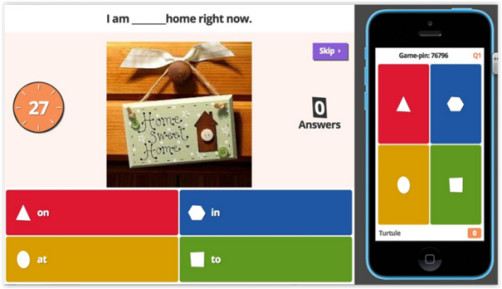 A question is identified as a multiple choice, true/false, puzzle or poll question. This flexibility is an additional support for participants and provides the user with multiple forms of data. When doing multiple choice questions, there are 4 possible answer options, but a user can choose as few as two options as well.
A question is identified as a multiple choice, true/false, puzzle or poll question. This flexibility is an additional support for participants and provides the user with multiple forms of data. When doing multiple choice questions, there are 4 possible answer options, but a user can choose as few as two options as well.
Often, I will use a Kahoot as a pretest for learners in order to ascertain how much background knowledge they may already have. As we proceed through our learning, I will use the same Kahoot (or modify it based on observations of learning) as a formative assessment. Finally, it can be an easy opportunity for students to practice their learning through a student-paced challenge, or as an assessment of learning. After the Kahoot is completed, the user has the option to download a report of the game. This will provide valuable data on which questions were difficult, as well as which participants are struggling to answer correctly.
Some final tips and suggestions for creating a great and popular Kahoot.
- Help new participants to learn how to login to your Kahoot. They will need the pin number that is randomly created for each Kahoot.
- Allow participants to be creative with their player names, without being offensive. In order to track student progress, it is important to make sure the user knows which names the participants are using.
- Try to make questions that include the students in your class in a positive way. Personalizing a Kahoot captures participants’ attention.
- It is also fun if you include an obviously incorrect answer that can keep participants engaged and laughing.
- Finally, it is possible to use a video for the opening of the Kahoot game. While participants are waiting for others to join the game, they can watch an entertaining and informative video.
If you are interested in trying a Kahoot for yourself, here is a challenge I created based on what you have now read about Kahoot. Here is the link – good luck! (The challenge has ended.)
Michelle Land, the NJTESOL/NJBE Vice President/President-Elect, teaches at Randolph Township Schools.
August 10, 2021
Building Momentum with Long-Term English Learners
By Louise El Yaafouri
 Louise El Yaafouri writes about English learners, or emergent multilinguals, who are socially bilingual but demonstrate gaps in their academic vocabulary in reading and writing. This most often occurs with emergent multilinguals who began as newcomers and initially seem to catch onto their second language quickly, but then their progress slows significantly and even stops.
Louise El Yaafouri writes about English learners, or emergent multilinguals, who are socially bilingual but demonstrate gaps in their academic vocabulary in reading and writing. This most often occurs with emergent multilinguals who began as newcomers and initially seem to catch onto their second language quickly, but then their progress slows significantly and even stops.
She suggests three strategies to help these students progress.
- Give students practice speaking and writing complete sentences, modeling them when repeating content information and supplying sentence frames.
- “Facilitate domain transfer.” These are cooperative activities such as project-based learning that involves speaking, listening, reading, and writing.
- Provide multiple exposures to the target language from the teacher, the student’s classmates, and other authentic sources will help students move forward in their language development.
Here are examples and additional links.
How To Help Students with Reading and L2 Acquisition
By Douglas Magrath
 Douglas Magrath lists three hints for using reading for faster L2 acquisition.
Douglas Magrath lists three hints for using reading for faster L2 acquisition.
- Have students work in groups so that they stay engaged in learning and build their skills in communication and problem-solving.
- Tap into children’s curiosity about how things work and why they happen to motivate them to read about these topics. Alongside this, the author suggests building vocabulary by creating word-association diagrams in class.
- Magrath contends that reading and writing are not separate skills and that they must be taught together. He proposes that reading should be the basis for writing, and that students should write about what they read. Reading broadens students’ perspectives and provides them models of different types of writing, which can be the basis for improving their grammar. Reading also helps students develop the ability to analyze other points of view.
The author states that “A strong foundation in reading skills will make it easier for ESL students to improve their writing skills and build up their vocabulary which will transfer to their speaking and listening skills as well.”
August 17, 2021
Mental Health Problems Loom for the COVID Generation. Here’s What Schools Can Do.
 Education Week recently published “Spotlight”, a series of seven articles on students’ mental health.
Education Week recently published “Spotlight”, a series of seven articles on students’ mental health.
The first one of these, “Mental Health Problems Loom For the COVID Generation. Here’s What Schools Can Do” is by Arianna Prothero. She acknowledges the need to help students catch up academically but also emphasizes the importance of meeting their emotional needs as well. She offers guidance for schools as they attempt this seemingly impossible task.
Prothero gives examples of what others have done, such as keeping a “watch list” of students who may experience problems. While students’ poor behavior can be expected, discipline will only exacerbate the issues. Another option could be to hire additional counselors and psychologists with Covid funds. Social-emotional learning is a necessity although implementing a new curriculum is not a good idea for the coming school year. She suggests partnerships with families and community resources.
She also advocates for support for teachers, especially setting up a schedule which would give them time for professional development, for planning, and for collaboration.
Read all of the suggestions here.
Helping Students Bounce Back from a Disrupted Year: Strategies for Schools
By Sarah D. Sparks
 Sparks offers strategies for getting students acclimated to being back at school and getting used to the routine of being in class. The author recommends using the model used with newcomers – emerging bilinguals who have had a disrupted school experience. She suggests that the focus should be on mental and emotional health, and academically, not on what was lost, but what was learned during the pandemic, not on remediation, but on acceleration.
Sparks offers strategies for getting students acclimated to being back at school and getting used to the routine of being in class. The author recommends using the model used with newcomers – emerging bilinguals who have had a disrupted school experience. She suggests that the focus should be on mental and emotional health, and academically, not on what was lost, but what was learned during the pandemic, not on remediation, but on acceleration.
There is some good news in the research about the effects of the disruption of school for students affected by a different disaster.
“Harris and his colleagues found that by about two years after the disaster, students who had lived through school displacement during Hurricane Katrina had returned to their expected academic trajectory before the storm. But he noted that students continued to show signs of trauma and mental health issues for years after that.”
Articles recommended by Tina Kern, NJTESOL/NJBE Exhibitor Liaison
Other articles you may want to read in this Spotlight
- ‘They Already Feel Like Bad Students.’ A Special Educator Reflects on Virtual Teaching
- Child Abuse Cases Got More Severe During COVID-19. Could Teachers Have Prevented It?
- Q&A: Meeting the Needs of Students of Color in a Time Of Collective Trauma
- How Students Want to Reimagine Education Next Year
August 24, 2021
What Students Will Need as the Year Begins
The author for this article, Lori Desautels, acknowledges that although learning was lost, more important than that is the mental health of students and teachers. She advises that teachers need to reach out and care for each other to create a safe space that provides a connected community to counter the isolation and loneliness experienced in the past year.
 Her advice is that to help students adjust to being in the classroom, predictability must be built into the daily schedule and routines. Activities that promote positive feelings are essential. She also recommends periodic brief “check ins” on how students are doing emotionally during the day. She also proposes starting with shorter lesson times, frequent breaks, and some movement to help students focus and learn.
Her advice is that to help students adjust to being in the classroom, predictability must be built into the daily schedule and routines. Activities that promote positive feelings are essential. She also recommends periodic brief “check ins” on how students are doing emotionally during the day. She also proposes starting with shorter lesson times, frequent breaks, and some movement to help students focus and learn.
Desautels closes by writing,
The rhythms of life are always about ruptures and repairs, and during the past year, our schools experienced a significant amount of rupture without the time, space, and opportunities to repair. We will need to acknowledge the adversity and trauma students have experienced and find new ways of repairing, leading, teaching, and living life with the emotional, mental, and physiological well-being that is the birthright of every human being.
Find the specific recommendations here.
‘You Can’t Lead on Empty’: On Supporting Staff With Vicarious Trauma
By Paige Tutt
 In another article from Edutopia, Paige Tutt interviewed Dr. Art McCoy about supporting school staff, especially teachers.
In another article from Edutopia, Paige Tutt interviewed Dr. Art McCoy about supporting school staff, especially teachers.
Dr. McCoy is the superintendent of the Jennings school district in Missouri, where the majority of students have experienced major trauma, such as a family member being jailed and homicides in the community. Supporting these students is often a drain on teachers, who may experience what he described as secondary trauma, exhibited by outbursts against students, harsh reactions, and burnout soon after a break from teaching.
Through partnerships with corporations, the district staff, in groups, were offered happy hours off campus with a therapist once a month, but this was not enough. The district developed other activities that, in time, were incorporated into its budget for ongoing support. And this empowered educators to be successful.
Dr. McCoy closed the interview by stating, “This is the most important part of every day, every lesson, every relationship—’How are you doing?’ comes before ‘What do you know or need to know?’ and ‘How are we doing?’ comes before ‘What do we need to know or do?’”
Read about how this support may be possible.
August 31, 2021
5 Ways to Support the Families of Multilingual Learners When School Opens
By Judie Haynes
 From her 28 years of teaching experience, Judie Haynes writes about how to help new multilingual students’ families prepare for the school year. This article on her blog for international TESOL encourages school leaders to assist these families from the perspective of those who are unfamiliar with school procedures.
From her 28 years of teaching experience, Judie Haynes writes about how to help new multilingual students’ families prepare for the school year. This article on her blog for international TESOL encourages school leaders to assist these families from the perspective of those who are unfamiliar with school procedures.
- To enroll children in school, parents need to know what documentation is required. Some may not have a birth certificate or may be afraid to share it because they think that the school will check their immigration status. Families need to be informed that immigration is outside of the school’s purview. Haynes suggests other documents that may be used to certify birth dates.
- School schedules, including holidays, half-days, and emergency closures, and how to find out about them, must be explained.
- Families need to know the school policies for absences and late arrivals.
They also must be informed about transportation options if there is a bus, or the procedures for dropping of and picking up children from school. - Fire, evacuation, and lockdown drills must also be clearly explained so that students won’t be frightened.
- If possible, all of this should be communicated in the families’ native languages.
Judie Haynes was President of NJTESOL/NJBE 2010-2012.
Welcoming Back English Learners
 In this podcast, the host, Zaidee Stavely, interviews Charlene Fried, an English teacher at Sierra Vista High School in California, a lecturer at California State University Los Angeles; and an adjunct professor at Loyola Marymount University.
In this podcast, the host, Zaidee Stavely, interviews Charlene Fried, an English teacher at Sierra Vista High School in California, a lecturer at California State University Los Angeles; and an adjunct professor at Loyola Marymount University.
Many of Fried’s students are low-income, and the pandemic has affected them the most. Some are newcomers while others are long-term English learners. There are those who are highly educated and others who have had no opportunity to attend school.
Stavely and Fried discuss returning to the classroom and how to build community with the students as they improve their speaking skills. Fried talks about building trust, establishing bonds, listening, and collaborating to build community. She stresses the importance of affirming students’ native languages and letting them use their home languages to learn English and other subjects. She gives them a lot of opportunities to practice speaking and tries to minimize their fear of making mistakes. Her students talk to each other and do assignments orally before trying to write.
Fried encourages them to share their experiences. They talk about how they feel about being in school again and how they want people to see them. She asks them to tell about one good thing that came out of the pandemic. She challenges them to give one or two words to describe their personality. These questions later develop into assignments.
Fried gave an example of an assignment that involved students’ families. It was based on the children’s book, “The Dot”, by Peter Riddles. Students discussed and wrote about what they wanted to become in the future, and then the parents responded with how they could help them reach their goals.
Listen for more ideas and the voices of successful students.
September 7, 2021
Assessment Strategies for English-Language Learners
 In this article, Larry Ferlazzo calls on four educators, Margo Gottlieb, Vivian Micolta Simmons, Cindy Garcia, and Karen Nemeth, to answer the question, “What are effective assessment strategies for multilingual learners?”
In this article, Larry Ferlazzo calls on four educators, Margo Gottlieb, Vivian Micolta Simmons, Cindy Garcia, and Karen Nemeth, to answer the question, “What are effective assessment strategies for multilingual learners?”
Margo Gottlieb begins by advising that teachers understand their students, their languages, cultures, and backgrounds. Then the purpose of the assessment must be determined. She describes three different types of assessment with examples for each.
- “Assessment as learning as a classroom practice is a student-driven activity that broadcasts multilingual learners’ voice, empowerment, and identity.”
- “Assessment for learning might begin with teacher and student conversations leading to collaboration in making mutually agreed upon learning goals.”
- “Assessment of learning at a classroom level is shaped by teachers, individually or as a department or grade-level team, with input from students.”
Vivian Micolta Simmons recommends a wide variety of both formal and informal assesecommendasments on her own language-learning experience. She uses these to make rtions to both parents and other teachers. Her range of assessments include activities for listening and reading, role-plays, games, quizzes, and pre- and post-tests.
Cindy Garcia uses rubrics, portfolios, and conferences. Rubrics provide clear criteria, so students can evaluate their assignments before they are graded, and the teacher can determine what the student still needs to learn. Portfolios show retention of concepts over a period of time. Student-teacher conferences give students the opportunity to demonstrate what they have learned, and then the teacher can address students’ questions or misunderstandings.
Karen Nemeth specializes in early-childhood education. She notes that children who are 4-5 years old should be assessed in both of their languages. Even if they are bilingual, their development is probably not the same in both languages. She also recommends using a portfolio that includes audio recordings while young students are involved in class activities. Information from students’ families is also important.
Read more to discover what might benefit your students.
Looking Back
 As part of my “To Do” list for breaks between semesters, I go back to past issues of Voices and reformat them to make the back end of the website easier to manage.
As part of my “To Do” list for breaks between semesters, I go back to past issues of Voices and reformat them to make the back end of the website easier to manage.
As I was going through Winter, Spring, and Summer, 2020, I found an amazing snapshot of what we’ve gone through and what we’ve accomplished.
I invite you to take a look.
- Winter 2020 – looking ahead in innocence to a clearer vision, not knowing what was coming. It seems like a different era.
- The Features announced the new Executive Director. Supporting our students was the primary concern.
- In SIGS, equity was the main topic, seeing assets, not deficits.
Then Spring 2020 – a fast and amazing transition to teaching online, stressful, but an accomplishment by all.
- In Features the topics were about finding resources for remote learning, encouraging each other, and taking care of ourselves.
- The SIGS focused on adapting and never losing sight of our purpose.
Finally, Summer 2020, looking back but also forward, still to the unknown.
- Summer Features announced the NJTESOL/NJBE “Statement of Solidarity against anti-black racism” and the online Leadership and Scholarship awards.
- Summer SIGS were about reflections and planning.
You will find the links to everything on the homepage.
Marilyn Pongracz is the NJTESOL/NJBE Technology Coordinator and the ESL Tutoring Supervisor at Bergen Community College.
September 14, 2021
Teach Us Your Name
By Kathleen Fernandez
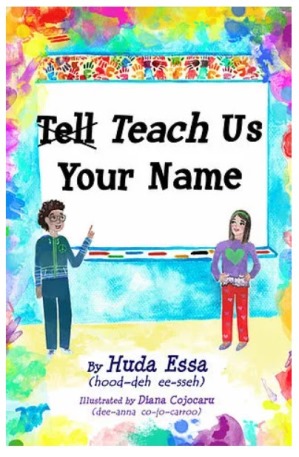 A tweet by Esther Park @MrsParkShine, led me to an amazing resource and an essential aspect of linguistic justice and equity for all students: the correct pronunciation of their names. In her book, Teach Us Your Name, Huda Essa writes about Kareenmalayaseenadeen, a young girl who dislikes her name because it is so different from the other names of students in her class. Her teacher tries to pronounce it, but gets it wrong, she asks if it is correct and Kareenmalayaseenadeen shakes her head yes because she is embarrassed. This story is true and my students repeatedly told me that teachers did not pronounce their names correctly. This is the cornerstone of personal respect, to know the true names of the students in your school community. Teach Us Your Name is a picture book, but carries a message that goes well beyond the elementary classroom. It would be a great way to begin a lesson on narrative to learn more about the people in your classroom and school.
A tweet by Esther Park @MrsParkShine, led me to an amazing resource and an essential aspect of linguistic justice and equity for all students: the correct pronunciation of their names. In her book, Teach Us Your Name, Huda Essa writes about Kareenmalayaseenadeen, a young girl who dislikes her name because it is so different from the other names of students in her class. Her teacher tries to pronounce it, but gets it wrong, she asks if it is correct and Kareenmalayaseenadeen shakes her head yes because she is embarrassed. This story is true and my students repeatedly told me that teachers did not pronounce their names correctly. This is the cornerstone of personal respect, to know the true names of the students in your school community. Teach Us Your Name is a picture book, but carries a message that goes well beyond the elementary classroom. It would be a great way to begin a lesson on narrative to learn more about the people in your classroom and school.

“From a foundation of caring about students’ names, teachers can build a broader sense of cultural capital.”
Beyond the book, I found an article by Huda Essa, “The Hidden Power in Your Class Roster“, published in ASCD Education Update. Ms. Essa describes her experience as a teacher, “I realized I had the power through my list of students’ names to foster learning and respect for cultural diversity – and to prevent my students from going through the same embarrassment and confusion I did with my own name”. This idea led to students in her classes learning to pronounce each other’s names correctly which spread to teachers in her school making an effort to call students by their proper names. The article goes on to give lesson suggestions to create a culturally responsive and inclusive classroom. In addition to the article is a TED talk Huda Essa·TEDxUofM: “Your Name is the Key!” For older students this would be a way to lead into these discussions instead of using Teach Us Your Name.
Referring back to Esther Park, in her tweet she also spoke about the importance of pronouncing students’ names correctly and shared a PowerPoint that she created for her classes based on Teach Us Your Name. It includes a video recording of the story and then a lesson guide to support students teaching others how to pronounce their names and how to ask others about the pronunciation of their names. This lesson uses Flipgrid, but could be modified for other audio formats. “Google slides Teach Me Your Name” [Created by Esther Park @MrsParkShine].
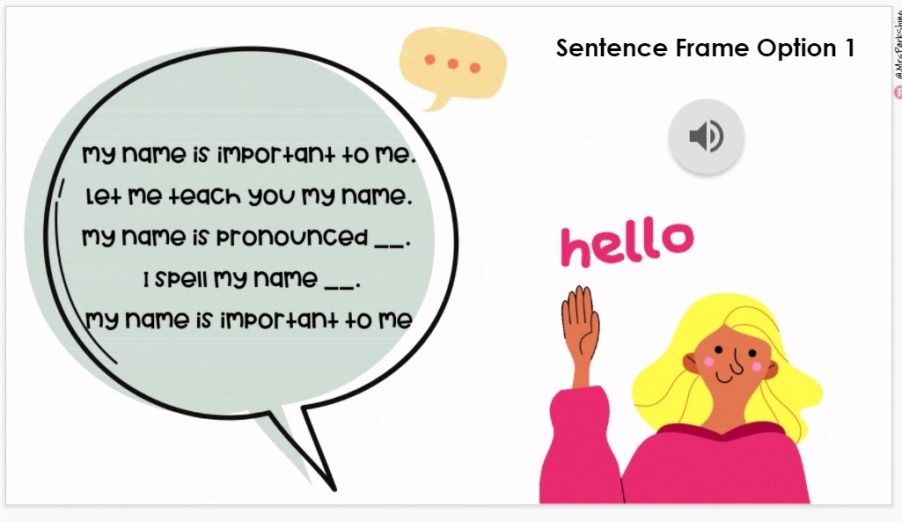 Ms. Essa relates that her name, Huda, means “positive guidance” and that this concept informs her professional practice. As the new school year begins, let this simple yet powerful gesture of respect and inclusion, pronouncing everyone’s name correctly, be the foundation of your school community.
Ms. Essa relates that her name, Huda, means “positive guidance” and that this concept informs her professional practice. As the new school year begins, let this simple yet powerful gesture of respect and inclusion, pronouncing everyone’s name correctly, be the foundation of your school community.
Huda Essa’s Website
Huda Essa reading Teach Me Your Name
Kathleen Fernandez is the Executive Director of NJTESOL/NJBE.
Conversations with Tim: A student’s perspective on living and learning during the pandemic
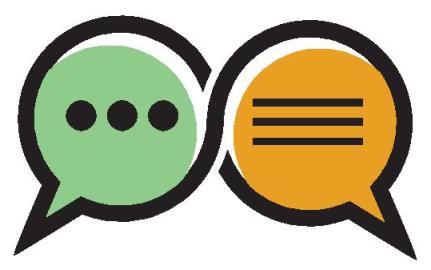 In Conversations with Tim, on June 4th of this year, Tim Boals, the WIDA founder and director, and Merideth Trahan, WIDA chief of staff, interviewed a multilingual high school student, Hazel Mendoza, for her viewpoint about the benefits of both remote and in-person learning.
In Conversations with Tim, on June 4th of this year, Tim Boals, the WIDA founder and director, and Merideth Trahan, WIDA chief of staff, interviewed a multilingual high school student, Hazel Mendoza, for her viewpoint about the benefits of both remote and in-person learning.
Of the benefits of staying home and learning remotely, Hazel named time with her family and having the opportunity to continue to use her native language as the most valuable experience. She enjoyed the Kahoot activities as a means of getting more involved in online classes. She also appreciated one-on-one teacher conferences and the slideshows of course content because she could refer back to them as needed.
Despite these advantages of online learning, she was looking forward to being in person in school again and to participating in activities, including and her favorite, volleyball. She mentioned that one difficulty she’s had was when teachers used big words that she didn’t understand, especially on a test.
Near the end of the interview, Tim Boals added that “There’s a saying in Spanish that ‘una persona que sabe dos idiomas, vale por dos.’ That saying is that when a person speaks two languages, they are worth two people.”
You can listen to the interview and read the transcript here.
September 21, 2021
Celebrating Hispanic Heritage Month
NCELA newsletter offers links to ideas for celebrating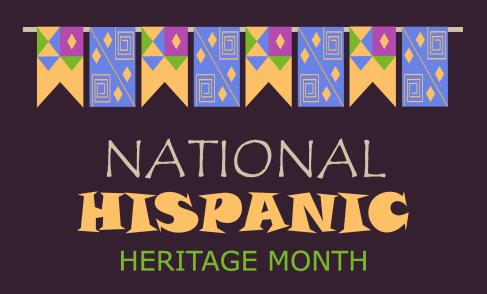 Spanish Heritage Month, September 15 to October 15th.
Spanish Heritage Month, September 15 to October 15th.
You will find facts, “During SY 2017–18, Spanish was the most common home language spoken by ELs, and states reported that out of all EL students, 3,749,314, or 74.82%, spoke Spanish.” and a supporting fact sheet to download.
A link to A Month of Ideas for Celebrating Hispanic Heritage from Scholastic provides 30 days of books to read, activities, food, music, art, research, and other websites to explore.
Another link to the Arizona Education Association website lists resources in three grade clusters, K-5, 6-8, and 9-12. One of these is a complete lesson plan for grades 3-5 with resources and standards from the Kennedy Center in which students can compare Halloween to the Day of the Dead.
The resources also include activities, background resources, quizzes, music, and videos. Another link takes you to Fact Monster with biographies of Notable Hispanic Americans, Spanish loan words or other facts related to Hispanic heritage. Students may also enjoy music clips from the Smithsonian Center for Folklife and Cultural Heritage.
There is something for all students on these sites.
Chapter Meetings Coming Soon!
Bergen County will be meeting virtually on Thursday Sept 30, at 4:30 with LeighAnn Matthews presenting; Removing the ELL Deficit Lens Register here
Passaic County will be meeting virtually on October 5, 21, and November 18 from 4:30-5:00.
Atlantic Cape May will be meeting on Wednesday October 13 4:30 at the Setaara Afghan French restaurant in Atlantic City. Topic: Useful Reports to Drive Teacher Instruction
Join us for NJTESOL/NJBE October Events
October is beginning with two exciting free events for NJTESOL-NJBE members.
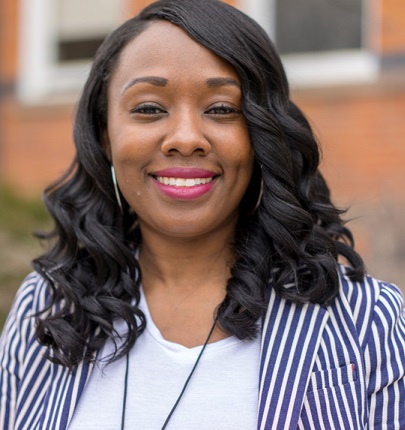
Dr. April Baker-Bell
The first is the culminating meeting for our Linguistic Justice: Black Language, Literacy, Identity, and Pedagogy book study. This presentation will be on October 8th at 7:00 with the author, Dr. April Baker-Bell. Since the presentation is focused on the text, it will feature conversation centered around implementing Black Language Pedagogy.
If you miss this event, Dr. Baker-Bell will also be the Wednesday, June 1 Keynote speaker at the NJTESOL/NJBE 2022 Spring Conference. The book study is sponsored by the Countering Anti-Black Racism and Advocacy Committees of NJTESOL/NJBE to promote linguistic justice for black multilingual learners as well as speakers of Black English.
The next day, October 9, join us at 8:30 for Looking and Learning about the 2020 WIDA
Standards Framework with NJTESOL/NJBE. This is the first in a series of four workshops dealing with the new WIDA Standards Framework and how they will impact New Jersey educators will deal with orientation to the 2020 Standards Framework by providing an overview of the document.
The next sessions will look more deeply into different specifics of the 2020 WIDA Standards Framework.
Registration for the first session is also on Eventbrite. Look for Weekly Voices and hotlist announcements for registration links for the later sessions.
Here are the topics and dates for all of the sessions:
10/9/2021 – Orientation to the 2020 WIDA Standards Framework
11/13/2021 – Exploring the Key Language Uses
2/5/2022 – Breaking Down the Framework
3/12/2022 – Moving Forward with the 2020 WIDA Standards Framework
 Visit our home page for links to past and present Voices issues.
Visit our home page for links to past and present Voices issues.
